Xinyue Zhang
Beyond Flatlands: Unlocking Spatial Intelligence by Decoupling 3D Reasoning from Numerical Regression
Nov 18, 2025Abstract:Existing Vision Language Models (VLMs) architecturally rooted in "flatland" perception, fundamentally struggle to comprehend real-world 3D spatial intelligence. This failure stems from a dual-bottleneck: input-stage conflict between computationally exorbitant geometric-aware encoders and superficial 2D-only features, and output-stage misalignment where discrete tokenizers are structurally incapable of producing precise, continuous numerical values. To break this impasse, we introduce GEODE (Geometric-Output and Decoupled-Input Engine), a novel architecture that resolves this dual-bottleneck by decoupling 3D reasoning from numerical generation. GEODE augments main VLM with two specialized, plug-and-play modules: Decoupled Rationale Module (DRM) that acts as spatial co-processor, aligning explicit 3D data with 2D visual features via cross-attention and distilling spatial Chain-of-Thought (CoT) logic into injectable Rationale Tokens; and Direct Regression Head (DRH), an "Embedding-as-Value" paradigm which routes specialized control tokens to a lightweight MLP for precise, continuous regression of scalars and 3D bounding boxes. The synergy of these modules allows our 1.5B parameter model to function as a high-level semantic dispatcher, achieving state-of-the-art spatial reasoning performance that rivals 7B+ models.
Stroke Modeling Enables Vectorized Character Generation with Large Vectorized Glyph Model
Nov 14, 2025Abstract:Vectorized glyphs are widely used in poster design, network animation, art display, and various other fields due to their scalability and flexibility. In typography, they are often seen as special sequences composed of ordered strokes. This concept extends to the token sequence prediction abilities of large language models (LLMs), enabling vectorized character generation through stroke modeling. In this paper, we propose a novel Large Vectorized Glyph Model (LVGM) designed to generate vectorized Chinese glyphs by predicting the next stroke. Initially, we encode strokes into discrete latent variables called stroke embeddings. Subsequently, we train our LVGM via fine-tuning DeepSeek LLM by predicting the next stroke embedding. With limited strokes given, it can generate complete characters, semantically elegant words, and even unseen verses in vectorized form. Moreover, we release a new large-scale Chinese SVG dataset containing 907,267 samples based on strokes for dynamically vectorized glyph generation. Experimental results show that our model has scaling behaviors on data scales. Our generated vectorized glyphs have been validated by experts and relevant individuals.
YuE: Scaling Open Foundation Models for Long-Form Music Generation
Mar 11, 2025Abstract:We tackle the task of long-form music generation--particularly the challenging \textbf{lyrics-to-song} problem--by introducing YuE, a family of open foundation models based on the LLaMA2 architecture. Specifically, YuE scales to trillions of tokens and generates up to five minutes of music while maintaining lyrical alignment, coherent musical structure, and engaging vocal melodies with appropriate accompaniment. It achieves this through (1) track-decoupled next-token prediction to overcome dense mixture signals, (2) structural progressive conditioning for long-context lyrical alignment, and (3) a multitask, multiphase pre-training recipe to converge and generalize. In addition, we redesign the in-context learning technique for music generation, enabling versatile style transfer (e.g., converting Japanese city pop into an English rap while preserving the original accompaniment) and bidirectional generation. Through extensive evaluation, we demonstrate that YuE matches or even surpasses some of the proprietary systems in musicality and vocal agility. In addition, fine-tuning YuE enables additional controls and enhanced support for tail languages. Furthermore, beyond generation, we show that YuE's learned representations can perform well on music understanding tasks, where the results of YuE match or exceed state-of-the-art methods on the MARBLE benchmark. Keywords: lyrics2song, song generation, long-form, foundation model, music generation
Semantic Web and Creative AI -- A Technical Report from ISWS 2023
Jan 30, 2025



Abstract:The International Semantic Web Research School (ISWS) is a week-long intensive program designed to immerse participants in the field. This document reports a collaborative effort performed by ten teams of students, each guided by a senior researcher as their mentor, attending ISWS 2023. Each team provided a different perspective to the topic of creative AI, substantiated by a set of research questions as the main subject of their investigation. The 2023 edition of ISWS focuses on the intersection of Semantic Web technologies and Creative AI. ISWS 2023 explored various intersections between Semantic Web technologies and creative AI. A key area of focus was the potential of LLMs as support tools for knowledge engineering. Participants also delved into the multifaceted applications of LLMs, including legal aspects of creative content production, humans in the loop, decentralised approaches to multimodal generative AI models, nanopublications and AI for personal scientific knowledge graphs, commonsense knowledge in automatic story and narrative completion, generative AI for art critique, prompt engineering, automatic music composition, commonsense prototyping and conceptual blending, and elicitation of tacit knowledge. As Large Language Models and semantic technologies continue to evolve, new exciting prospects are emerging: a future where the boundaries between creative expression and factual knowledge become increasingly permeable and porous, leading to a world of knowledge that is both informative and inspiring.
A Machine Learning Approach for Emergency Detection in Medical Scenarios Using Large Language Models
Dec 20, 2024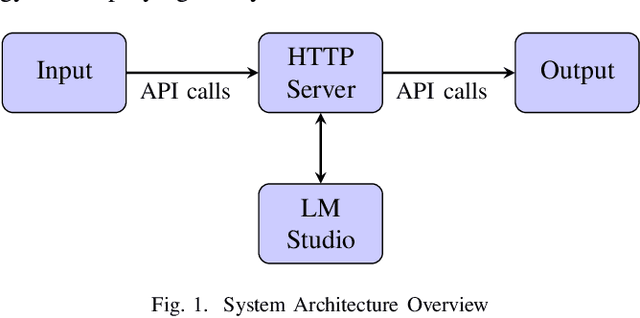
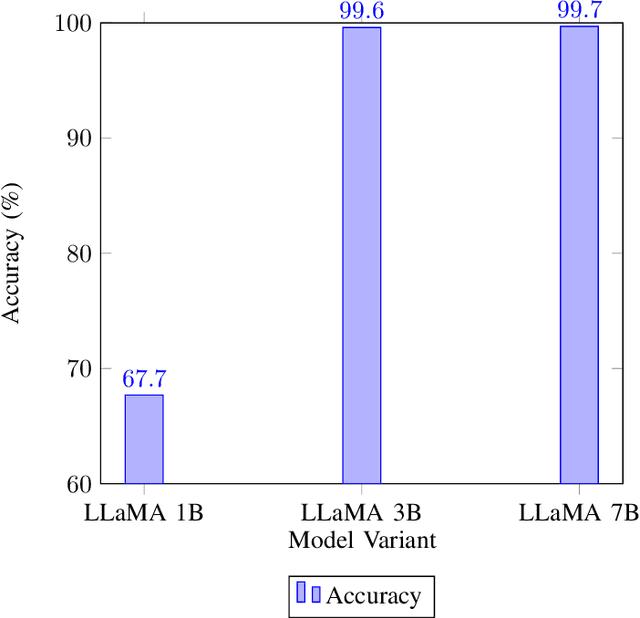
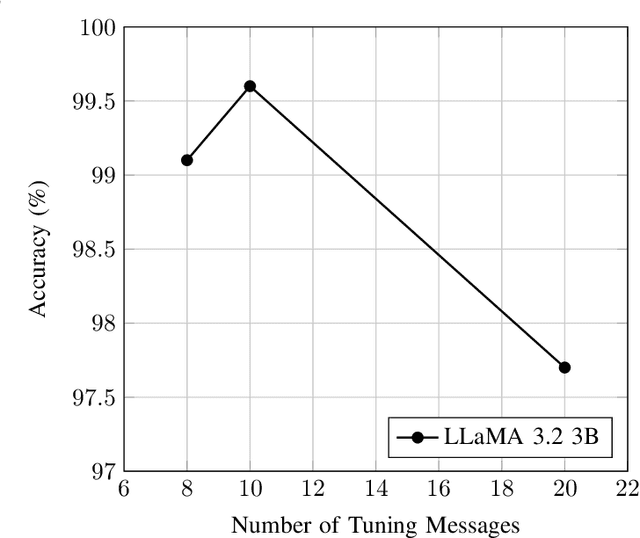

Abstract:The rapid identification of medical emergencies through digital communication channels remains a critical challenge in modern healthcare delivery, particularly with the increasing prevalence of telemedicine. This paper presents a novel approach leveraging large language models (LLMs) and prompt engineering techniques for automated emergency detection in medical communications. We developed and evaluated a comprehensive system using multiple LLaMA model variants (1B, 3B, and 7B parameters) to classify medical scenarios as emergency or non-emergency situations. Our methodology incorporated both system prompts and in-prompt training approaches, evaluated across different hardware configurations. The results demonstrate exceptional performance, with the LLaMA 2 (7B) model achieving 99.7% accuracy and the LLaMA 3.2 (3B) model reaching 99.6% accuracy with optimal prompt engineering. Through systematic testing of training examples within the prompts, we identified that including 10 example scenarios in the model prompts yielded optimal classification performance. Processing speeds varied significantly between platforms, ranging from 0.05 to 2.2 seconds per request. The system showed particular strength in minimizing high-risk false negatives in emergency scenarios, which is crucial for patient safety. The code implementation and evaluation framework are publicly available on GitHub, facilitating further research and development in this crucial area of healthcare technology.
InternLM-XComposer2.5-OmniLive: A Comprehensive Multimodal System for Long-term Streaming Video and Audio Interactions
Dec 12, 2024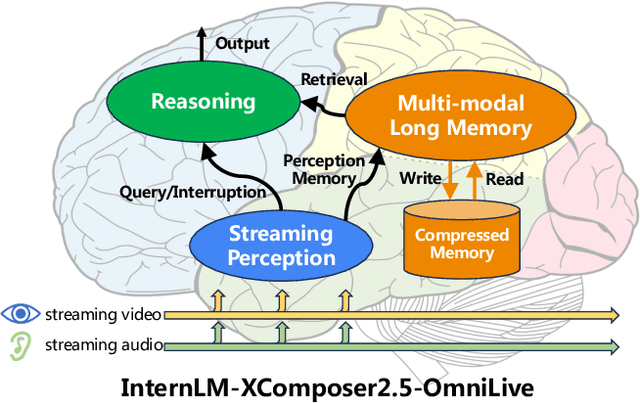
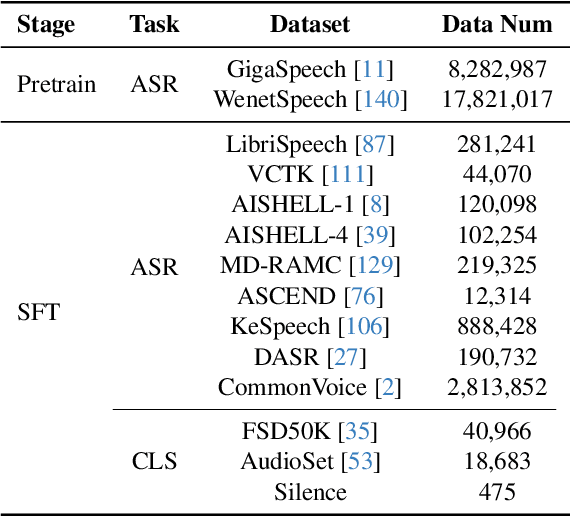
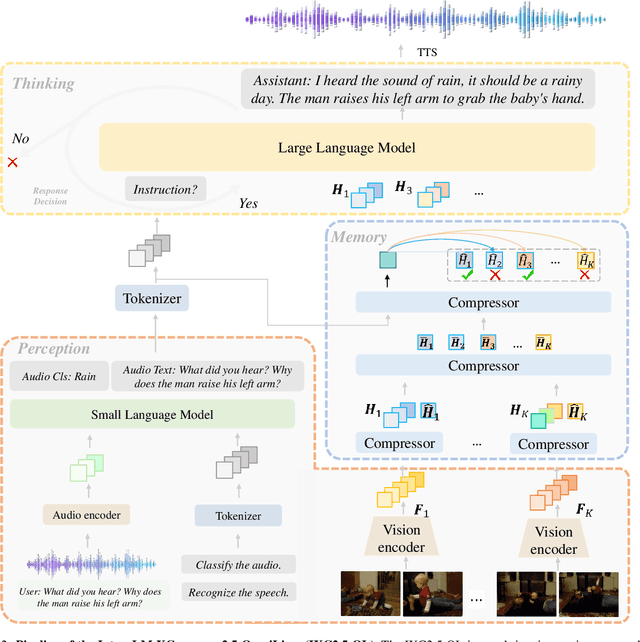
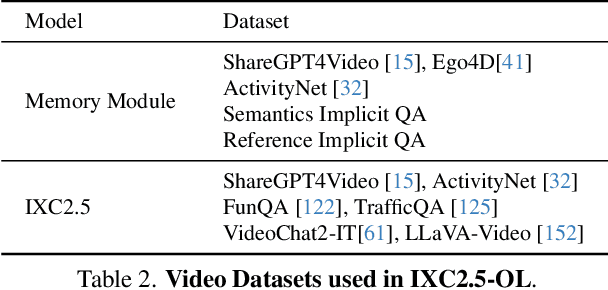
Abstract:Creating AI systems that can interact with environments over long periods, similar to human cognition, has been a longstanding research goal. Recent advancements in multimodal large language models (MLLMs) have made significant strides in open-world understanding. However, the challenge of continuous and simultaneous streaming perception, memory, and reasoning remains largely unexplored. Current MLLMs are constrained by their sequence-to-sequence architecture, which limits their ability to process inputs and generate responses simultaneously, akin to being unable to think while perceiving. Furthermore, relying on long contexts to store historical data is impractical for long-term interactions, as retaining all information becomes costly and inefficient. Therefore, rather than relying on a single foundation model to perform all functions, this project draws inspiration from the concept of the Specialized Generalist AI and introduces disentangled streaming perception, reasoning, and memory mechanisms, enabling real-time interaction with streaming video and audio input. The proposed framework InternLM-XComposer2.5-OmniLive (IXC2.5-OL) consists of three key modules: (1) Streaming Perception Module: Processes multimodal information in real-time, storing key details in memory and triggering reasoning in response to user queries. (2) Multi-modal Long Memory Module: Integrates short-term and long-term memory, compressing short-term memories into long-term ones for efficient retrieval and improved accuracy. (3) Reasoning Module: Responds to queries and executes reasoning tasks, coordinating with the perception and memory modules. This project simulates human-like cognition, enabling multimodal large language models to provide continuous and adaptive service over time.
Homotopy Continuation Made Easy: Regression-based Online Simulation of Starting Problem-Solution Pairs
Nov 06, 2024Abstract:While automatically generated polynomial elimination templates have sparked great progress in the field of 3D computer vision, there remain many problems for which the degree of the constraints or the number of unknowns leads to intractability. In recent years, homotopy continuation has been introduced as a plausible alternative. However, the method currently depends on expensive parallel tracking of all possible solutions in the complex domain, or a classification network for starting problem-solution pairs trained over a limited set of real-world examples. Our innovation consists of employing a regression network trained in simulation to directly predict a solution from input correspondences, followed by an online simulator that invents a consistent problem-solution pair. Subsequently, homotopy continuation is applied to track that single solution back to the original problem. We apply this elegant combination to generalized camera resectioning, and also introduce a new solution to the challenging generalized relative pose and scale problem. As demonstrated, the proposed method successfully compensates the raw error committed by the regressor alone, and leads to state-of-the-art efficiency and success rates while running on CPU resources, only.
Mobility-LLM: Learning Visiting Intentions and Travel Preferences from Human Mobility Data with Large Language Models
Oct 29, 2024



Abstract:Location-based services (LBS) have accumulated extensive human mobility data on diverse behaviors through check-in sequences. These sequences offer valuable insights into users' intentions and preferences. Yet, existing models analyzing check-in sequences fail to consider the semantics contained in these sequences, which closely reflect human visiting intentions and travel preferences, leading to an incomplete comprehension. Drawing inspiration from the exceptional semantic understanding and contextual information processing capabilities of large language models (LLMs) across various domains, we present Mobility-LLM, a novel framework that leverages LLMs to analyze check-in sequences for multiple tasks. Since LLMs cannot directly interpret check-ins, we reprogram these sequences to help LLMs comprehensively understand the semantics of human visiting intentions and travel preferences. Specifically, we introduce a visiting intention memory network (VIMN) to capture the visiting intentions at each record, along with a shared pool of human travel preference prompts (HTPP) to guide the LLM in understanding users' travel preferences. These components enhance the model's ability to extract and leverage semantic information from human mobility data effectively. Extensive experiments on four benchmark datasets and three downstream tasks demonstrate that our approach significantly outperforms existing models, underscoring the effectiveness of Mobility-LLM in advancing our understanding of human mobility data within LBS contexts.
How Initial Connectivity Shapes Biologically Plausible Learning in Recurrent Neural Networks
Oct 15, 2024Abstract:The impact of initial connectivity on learning has been extensively studied in the context of backpropagation-based gradient descent, but it remains largely underexplored in biologically plausible learning settings. Focusing on recurrent neural networks (RNNs), we found that the initial weight magnitude significantly influences the learning performance of biologically plausible learning rules in a similar manner to its previously observed effect on training via backpropagation through time (BPTT). By examining the maximum Lyapunov exponent before and after training, we uncovered the greater demands that certain initialization schemes place on training to achieve desired information propagation properties. Consequently, we extended the recently proposed gradient flossing method, which regularizes the Lyapunov exponents, to biologically plausible learning and observed an improvement in learning performance. To our knowledge, we are the first to examine the impact of initialization on biologically plausible learning rules for RNNs and to subsequently propose a biologically plausible remedy. Such an investigation could lead to predictions about the influence of initial connectivity on learning dynamics and performance, as well as guide neuromorphic design.
fCOP: Focal Length Estimation from Category-level Object Priors
Sep 29, 2024



Abstract:In the realm of computer vision, the perception and reconstruction of the 3D world through vision signals heavily rely on camera intrinsic parameters, which have long been a subject of intense research within the community. In practical applications, without a strong scene geometry prior like the Manhattan World assumption or special artificial calibration patterns, monocular focal length estimation becomes a challenging task. In this paper, we propose a method for monocular focal length estimation using category-level object priors. Based on two well-studied existing tasks: monocular depth estimation and category-level object canonical representation learning, our focal solver takes depth priors and object shape priors from images containing objects and estimates the focal length from triplets of correspondences in closed form. Our experiments on simulated and real world data demonstrate that the proposed method outperforms the current state-of-the-art, offering a promising solution to the long-standing monocular focal length estimation problem.
 Add to Chrome
Add to Chrome Add to Firefox
Add to Firefox Add to Edge
Add to Edge